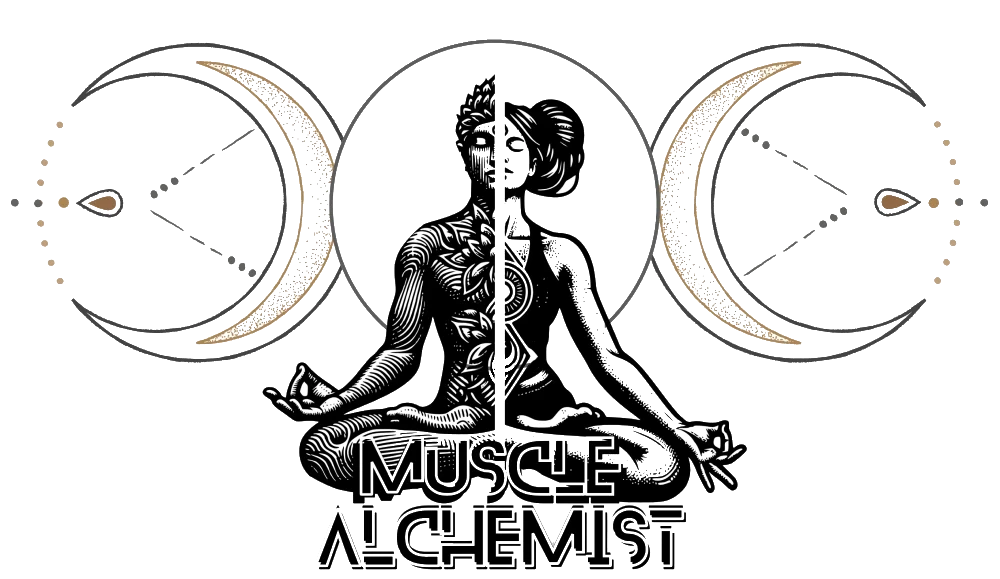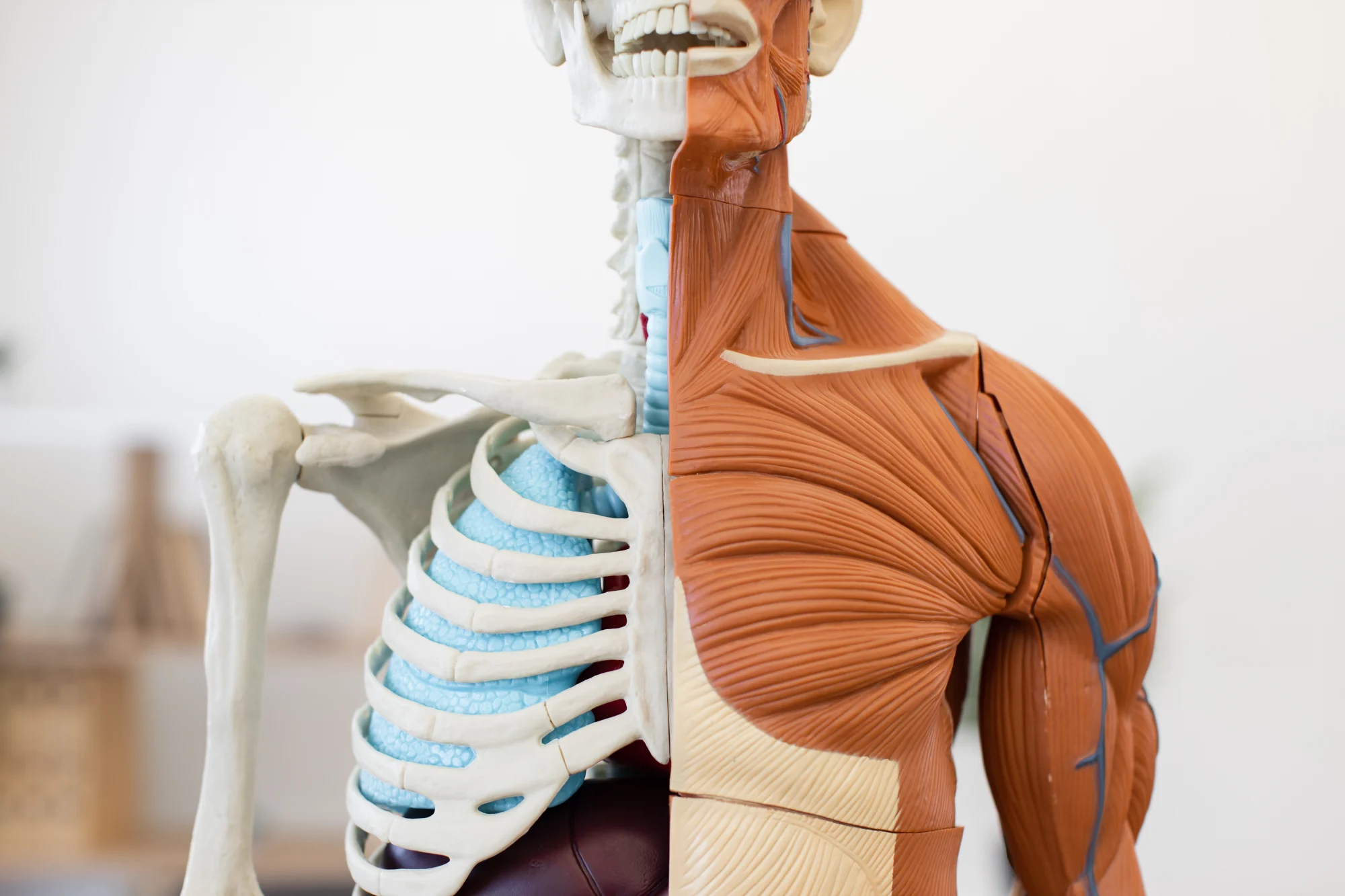The muscular system is your body’s powerhouse—literally. It’s responsible for every movement you make, from the simplest blink of an eye to the most powerful sprint. Understanding how your muscles work, adapt, and recover is essential whether you’re just starting out on your fitness journey or aiming to reach an elite level in sport. In this chapter, we’ll explore the muscles’ anatomy and function, how they generate force, common issues that can derail your progress, and practical strategies to keep your muscles strong, healthy, and ready for action.
1. What Is the Muscular System?
At its core, the muscular system is a network of over 600 individual muscles that convert chemical energy into mechanical work. When your brain sends a signal via the nervous system, specific muscle fibers contract, creating the force necessary to move bones, stabilize joints, pump blood, and even digest food. Without muscles, you wouldn’t be able to stand, breathe, smile, or run.
2. Types of Muscle Tissue
Your body contains three distinct types of muscle tissue, each with its own structure and role:
- Skeletal Muscle
Skeletal muscles attach to your bones via tendons. You control them consciously—when you decide to lift a weight or take a step, you’re activating skeletal muscle. Under the microscope, these muscles appear striated (striped) because of the organized arrangement of contractile proteins. - Cardiac Muscle
Found only in the heart, cardiac muscle contracts automatically and rhythmically to pump blood. Though it’s also striated, you can’t consciously control it. Its cells are uniquely interconnected, allowing coordinated contraction and a constant heartbeat. - Smooth Muscle
Smooth muscle lines the walls of internal organs—such as your stomach, intestines, and blood vessels. It’s non-striated and involuntary, meaning it contracts without you having to think about it. These contractions move food through your digestive tract and regulate blood flow by adjusting vessel diameter.
3. Anatomy of a Muscle
Each skeletal muscle is composed of bundles called fascicles, which are themselves made up of individual muscle fibers (cells). Here’s how they break down:
- Muscle Fiber (Cell)
- A single muscle fiber can be as long as the muscle itself.
- Contains multiple nuclei and a high density of mitochondria to generate energy.
- Myofibrils
- Inside each fiber are thousands of myofibrils, thread-like structures.
- Composed of repeating units called sarcomeres, the functional units of muscle contraction.
- Sarcomere
- Made up of thin (actin) and thick (myosin) filaments.
- The sliding of these filaments past each other is what shortens the muscle and produces force.
- Connective Tissue Layers
- Endomysium surrounds each fiber.
- Perimysium wraps bundles of fibers (fascicles).
- Epimysium encases the entire muscle.
- These layers transmit force and allow muscles to glide past one another.
- Tendons
- Dense cords of connective tissue that anchor muscle to bone.
- Transmit the force your muscles generate, resulting in movement.
4. How Muscles Contract: The Sliding Filament Theory
Muscle contraction is an elegant chemical-mechanical process:
- Signal Initiation
- A nerve impulse arrives at the muscle’s neuromuscular junction, releasing the neurotransmitter acetylcholine.
- Calcium Release
- The impulse travels deep into the fiber via T-tubules, triggering the sarcoplasmic reticulum to release calcium ions.
- Cross-Bridge Formation
- Calcium binds to troponin, shifting tropomyosin away from binding sites on actin.
- Myosin heads attach to actin, forming cross-bridges.
- Power Stroke
- Myosin heads pivot, pulling actin filaments inward—this shortens the sarcomere and generates tension.
- ATP-Driven Release
- ATP binds to myosin, releasing it from actin and resetting the head for another cycle.
- Relaxation
- When the nerve impulse stops, calcium is pumped back into the sarcoplasmic reticulum, tropomyosin covers binding sites, and the muscle fiber relaxes.
5. Roles of the Muscular System
Muscles do far more than move bones:
- Movement & Locomotion
Skeletal muscles contract in coordinated patterns to propel you forward, lift objects, and perform intricate tasks such as typing or playing an instrument. - Posture & Stability
Even when you’re standing still, muscles in your back, core, and legs contract to keep you upright, maintain balance, and stabilize joints. - Heat Production
Up to 80% of the energy used during muscle contraction is released as heat, helping maintain your core temperature. - Circulation & Digestion
Cardiac muscle keeps blood flowing; smooth muscle moves food through your digestive system and regulates blood vessel diameter.
6. Muscle Fitness: Strength, Endurance, and Hypertrophy
Improving your muscular system involves three key fitness goals:
- Muscular Strength
The maximal force that a muscle or muscle group can generate in a single effort.
- Your ability to produce maximal force in a single effort (e.g., a one-rep max bench press).
- Build it with heavy resistance and low repetitions (3–6 reps per set).
- Muscular Endurance
The ability of a muscle or group of muscles to sustain repeated contractions over time.
- Your muscle’s ability to sustain repeated contractions over time (e.g., maintaining a plank).
- Train it with lighter loads and high repetitions (12–20+ reps).
- Hypertrophy
An increase in the size of muscle cells, often the goal of resistance training.
- The process of increasing muscle fiber size to create larger, more powerful muscles.
- Achieved through moderate loads and moderate repetitions (6–12 reps), combined with adequate volume and recovery.
7. Adaptation and Growth
Your muscles adapt to training through two main processes:
- Neuromuscular Adaptation
Early strength gains (first 4–6 weeks) are largely due to improved coordination between your nervous system and muscle fibers, enabling more efficient recruitment of motor units. - Structural Adaptation
Continued training stimulates protein synthesis and satellite cell activation within muscle fibers, leading to hypertrophy and increased contractile machinery.
8. Common Muscle Disorders and Injuries
No one is immune to muscle setbacks. Here are a few to watch for:
- Strains and Tears
Overstretching or overloading can damage fibers and connective tissue, leading to pain and weakness. - Cramps
Sudden, involuntary muscle contractions often caused by dehydration, electrolyte imbalance, or fatigue. - Tendinopathy
Chronic tendon irritation (tendonitis) or degeneration (tendinosis) from repetitive stress without adequate recovery. - Muscular Dystrophy
A group of genetic disorders causing progressive muscle weakness and wasting.
9. Optimizing Muscle Health: Training, Nutrition, and Recovery
To keep your muscles strong, resilient, and ready for growth, focus on:
- Balanced Training Program
- Strength Days: Heavy resistance, low rep schemes.
- EnduranceDays: Lighter weights, higher reps or bodyweight circuits.
Endurance is the ability of the body or a specific muscle group to sustain prolonged physical activity without fatigue.
- Flexibility & Mobility: Daily stretching or yoga to maintain range of motion.
- Progressive Overload
The systematic increase of stress placed on the body during training to stimulate muscle growth and strength gains.
- Gradually increase weight, volume, or intensity to continually challenge your muscles.
- Proper Nutrition
- Protein: Aim for 1.6–2.2 g per kg of body weight per day to support repair and growth.
- Carbohydrates: Fuel high-intensity sessions and replenish glycogen stores.
- Fats: Support hormone production and overall health.
- Hydration & Electrolytes
- Water is essential for nutrient transport and waste removal.
- Replace lost sodium, potassium, and magnesium—especially after intense or prolonged workouts.
- Rest and Recovery
- Muscles grow during rest, not while you train.
- Aim for 7–9 hours of quality sleep nightly and incorporate rest days or active recovery (light movement, foam rolling).
10. The Muscular System in Sports Performance
Elite athletes leverage specific strategies to maximize muscular performance:
- Periodization
Structured training phases (e.g., hypertrophy, strength, power) designed to peak performance at the right time. - Plyometrics
Explosive exercises that train muscles to generate force rapidly, improving sprint speed and jump height. - Sport-Specific Conditioning
Tailoring exercises to mimic the movement patterns, energy demands, and muscle groups used in a particular sport. - Injury Prevention Protocols
Incorporating stability, balance, and eccentric loading exercises to reinforce musculotendinous units against high loads.
11. Conclusion
Your muscular system is an intricate, adaptable network that powers every movement, stabilizes your body, and maintains essential life processes. By understanding its anatomy and physiology, adopting a balanced training regimen, fueling your body properly, and allowing for adequate recovery, you can ensure your muscles stay strong, healthy, and capable—whether you’re pursuing everyday fitness or excelling in competitive sport. Remember: progress is a journey. Celebrate small victories, listen to your body, and adjust your approach as you grow stronger day by day.

